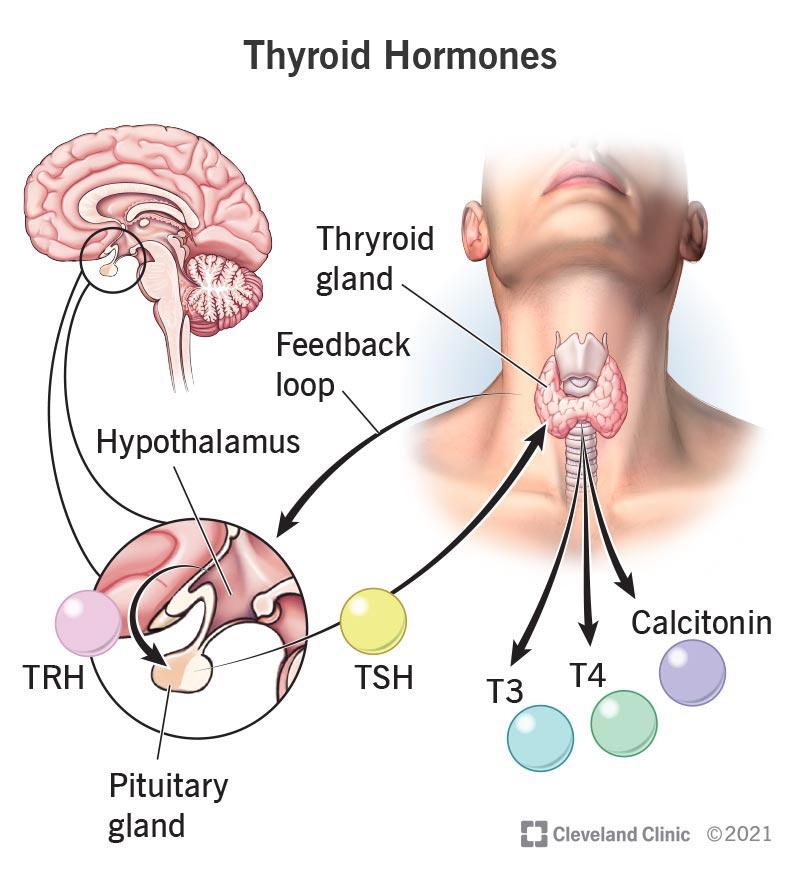Thyroid hormone is the hormone that controls your body’s metabolism, the process in which your body transforms the food you eat into energy. The two main hormones your thyroid releases — thyroxine (T4) and triiodothyronine (T3) — collectively make up thyroid hormone.
Advertisement
Cleveland Clinic is a non-profit academic medical center. Advertising on our site helps support our mission. We do not endorse non-Cleveland Clinic products or services. Policy

Thyroid hormone is the hormone that’s mainly responsible for controlling the speed of your body’s metabolism. In infants, thyroid hormone is critical for brain development. Your thyroid, a small, butterfly-shaped gland located at the front of your neck under your skin, makes and releases thyroid hormone. It’s a part of your endocrine system.
Advertisement
Cleveland Clinic is a non-profit academic medical center. Advertising on our site helps support our mission. We do not endorse non-Cleveland Clinic products or services. Policy
Hormones are chemicals that coordinate different functions in your body by carrying messages through your blood to your organs, muscles and other tissues. These signals tell your body what to do and when to do it.
Metabolism is the complex process of how your body transforms the food you consume into energy. All of the cells in your body need energy to function.
Thyroid hormone actually represents the combination of the two main hormones that your thyroid gland releases: thyroxine (T4) and triiodothyronine (T3). They’re often collectively referred to as “thyroid hormone” because T4 is largely inactive, meaning it doesn’t impact your cells, whereas T3 is active. Once your thyroid releases T4, certain organs in your body transform it into T3 so that it can impact your cells and your metabolism.
Your thyroid also releases a hormone called calcitonin to help regulate calcium levels in your blood by decreasing it. Calcitonin isn’t grouped into the “thyroid hormone” name, and it doesn’t impact your body’s metabolism like T3 and T4 do.
The production and release of thyroid hormone — thyroxine (t4) and triiodothyronine (T3) — is controlled by a feedback loop system that involves the following:
Advertisement
Your hypothalamus is the part of your brain that controls functions like blood pressure, heart rate, body temperature and digestion.
Your pituitary gland is a small, pea-sized gland located at the base of your brain below your hypothalamus. It makes and releases eight hormones.
Your pituitary gland is connected to your hypothalamus through a stalk of blood vessels and nerves. This is called the pituitary stalk. Through the stalk, your hypothalamus communicates with your pituitary gland and tells it to release certain hormones.
To start the feedback loop, your hypothalamus releases thyroid-releasing hormone (TRH) which, in turn, stimulates your pituitary gland to produce and release thyroid-stimulating hormone (TSH). TSH then triggers your thyroid to produce T4 and T3. Of the total amount of hormones that TSH triggers your thyroid to release, about 80% is T4 and 20% is T3. Your thyroid also needs adequate amounts of iodine, a substance you get from the food you eat, to create T4 and T3.
This hormone chain reaction is regulated by a feedback loop so that when the levels of T3 and T4 increase, they prevent the release of TRH (and thus TSH). When T3 and T4 levels drop, the feedback loop starts again. This system allows your body to maintain a constant level of thyroid hormones in your body.
If there are any issues with your hypothalamus, pituitary gland or thyroid, it can result in an imbalance in the hormones involved in this system, including T3 and T4.
Once your thyroid releases thyroxine (T4) into your bloodstream, certain cells in your body transform it into triiodothyronine (T3) through a process called de-iodination. This is because cells that have receptors that receive the effect of thyroid hormone are better able to use T3 than T4. Therefore, T4 is generally considered to be the inactive form of thyroid hormone, and T3 is considered the active form of it.
Cells in the following tissues, glands, organs and body systems can convert T4 to T3:
Thyroid hormone (T3 and T4) affects every cell and all the organs in your body by:
Advertisement
Several blood tests can measure your thyroid levels and assess how well your thyroid is working. These tests are often called thyroid function tests and include:
Your provider may order additional tests to assess your thyroid function, including:
Several conditions can result from or cause abnormal thyroid hormone levels. Thyroid disease is very common, with an estimated 20 million people in the United States having some type of thyroid condition. Females are about five to eight times more likely than males to have a thyroid condition.
Thyroid conditions include:
Advertisement
Issues with your pituitary gland or hypothalamus can also cause abnormal thyroid hormone levels since they help control thyroid hormone levels.
Abnormal thyroid hormone levels usually cause noticeable symptoms. Since thyroid hormone is responsible for controlling the speed of your metabolism, too much thyroid hormone can make it faster than normal and too little thyroid hormone can slow it down. These imbalances cause certain symptoms, including:
If you experience these symptoms, contact your healthcare provider. They can run some simple blood tests to see if your thyroid hormone levels are irregular.
Thyroid hormone is an essential hormone that affects many aspects of your body. Sometimes, you can have too little or too much thyroid hormone. The good news is that thyroid conditions are highly treatable. If you’re experiencing any thyroid hormone-related symptoms or want to know if you have any risk factors for developing thyroid disease, don’t be afraid to talk to your healthcare provider. They’re there to help you.
Advertisement
Hormonal conditions can be tricky to find and complicated to treat. The experts in endocrinology at Cleveland Clinic are here to provide the best care.

Last reviewed on 02/15/2022.
Learn more about the Health Library and our editorial process.